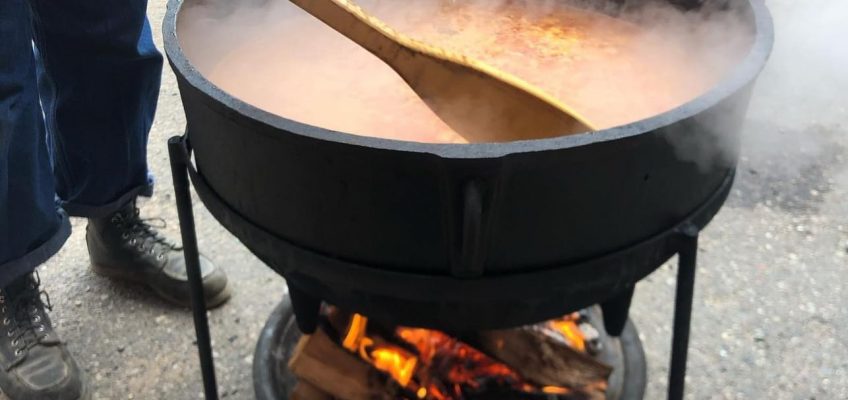For months, if not years, the shed-like, one-story building at 1350 Hague Ave. sat largely unattended at the edge of a Hamline Avenue service road, on a small spit of land that runs beneath Ayd Mill Road and the Hamline Avenue bridge. A house on the site was demolished in 2018.
Bradley Taylor, who lives within walking distance, figured the small black box of a building would be an affordable place to launch The Donut Trap, an homage to his favorite Los Angeles doughnut shop and his love of the arts. Backed by city STAR grant funding to fix up the heating, ventilation and air conditioning, Taylor opened his coffee, ice cream and doughnut counter this summer with the support of the Union Park District Council and others eager to see him succeed.
The Donut Trap’s exterior mural and hot pink front door have helped draw families from a nearby playground on the other side of the bridge. What hasn’t helped is a $5,000 bill from the city for purchasing a vacant building that is no longer vacant.
Surprised by an outstanding vacant building fee that has more than doubled his tax assessment, Taylor took his concerns to the Department of Safety and Inspections, and then to Ramsey County, and then to the city’s legislative hearing officer, and finally to the St. Paul City Council.
Disagreement, ambiguity
The strange, years-long saga of the Donut Trap’s vacant building fee came to a close on Wednesday when the city council agreed to meet the budding shop owner — the self-proclaimed “Black Martha Stewart” — halfway and voted 5-2 to cut his special assessment in half, even though it had already been added to his tax statement.
The unusual decision followed some disagreement and ambiguity over whether Taylor had been told by city inspections to ignore the fee while he was in the process of installing the Donut Trap with some $24,000 in STAR grant funding from the mayor’s office and the Ward 1 council office.
At the very least, “DSI failed to ask Ms. Taylor and Mr. Taylor if they understood St. Paul’s vacant building program,” wrote Sarah Dvorak, president of the Union Park District Council, in a letter to the city last month, which was later backed by the Lexington-Hamline Community Council.
The vote also followed strong words from the city attorney’s office to Ward 1 Council Member Anika Bowie, who was advised in a two-page letter to recuse herself from the vote. She did not.
“This is not a problem property,” said Bowie on Wednesday, urging the council to cut a new business some slack. “This is not a property that is in the vacant building program. This is a building that operates as a doughnut shop. They are done with all of their (upkeep), as far as being up to code. The thing that complicates this is there was a change in ownership.”
The $5,000 vacant building fee, according to Taylor’s appeal to the council, was incurred by a previous owner and then added to his property taxes after he had filled the long-underutilized structure with a menu inspired by his own sweet tooth and love of pop culture.
Taylor has maintained that when he inquired with DSI about the vacant building notices, he was advised by city employees to ignore them, and that he had text messages proving as much. DSI officials have said no such conversations took place.
Vacant building fee
The building was enrolled in the city’s vacant building program in April 2019, a few years before Taylor acquired the property, according to the city’s Department of Safety and Inspections.
“We purchased the building in May 2023 and immediately filed for sewer permit, building permit, plumbing permit, gas permit, etc.,” wrote Taylor, in an email last May to Marcia Moermond, the city’s legislative hearing officer.
“Shortly afterward we began receiving letters regarding a vacant building fee,” he added. “We were very concerned since it was for a large dollar amount, so we reached out multiple times to DSI — via phone, text, and even in person — and were repeatedly told it was a mistake. We were advised not to worry about the letters and that no further action was needed on our part. At no point were we informed that we needed to formally appeal or take additional steps.”
“I even visited the DSI office in person for clarity, where I was again told the issue would be resolved and to ignore the notices,” he wrote.
Ashley Taylor, who co-owns the property, testified before Moermond this June: “We called every time we got a letter or notice. We received the same answer every time we contacted someone. Our confusion is we called multiple vacant building inspectors in 2023. What could we have done differently when we feel we were proactive … and (were) told it was a mistake?”
Taylor’s appeal won the support of the Union Park District Council, which assembled a timeline of events to share with the city council. Several neighborhood residents have expressed relief to see a derelict building find a new public-facing purpose.
‘Eat Donutz, Keep It Sexy’
The building’s exterior, previously painted industrial black, has been redecorated with a dynamic collage of splashy colors. Benches now line the patio. Taylor’s menu is no less bold, with inventive ice cream, coffee and doughnut flavors promising a quick sugar high.
Under the motto “Eat Donutz, Keep It Sexy,” the Donut Trap’s wide-ranging temptations include the Gay 90s (a vanilla glazed doughnut encrusted with Fruity Pebbles cereal), the Thotiana (a churro and tres leches-flavored doughnut) and a Coca-Cola Cold Brew (“Bubbly. Buzzed. A little wrong, but somehow so, so right.”).
Behind the scenes, the wrangles with City Hall have been less joyous.
On Dec. 3, 2023, the unpaid $5,000 vacant building fee — representing a year of vacancy — was forwarded to Ramsey County, to be added to the Donut Trap’s property tax notice. The building was released from the city’s vacant building program in March of 2024, at which time Taylor was sent a reminder of the fee, which was neither paid nor appealed at the time, according to the city.
During a public hearing last month on Taylor’s appeal, Bowie asked the council for a two-week layover, giving Taylor time to produce copies of the communications from DSI.
“I asked if they would please provide those text messages,” said legislative hearing officer Marcia Moermond, addressing the council on Wednesday. “Those text messages did not come forward.”
The vote
Council Member Nelsie Yang, who cast one of two votes against reducing or refunding the assessment, said she could not support a fee reduction without evidence. “The fact that we haven’t received anything is really disappointing,” Yang said.
Bowie this week was advised by the city attorney’s office that she had been seen conversing with the Taylors in the hallway outside the council chambers, which could be construed as stepping outside of her role as a neutral party in an appeals hearing. For appeals, council members serve quasi-judicial roles, and are expected to steer clear of dealings with either side.
Bowie denied that she held a hallway conversation, though she said her legislative aide talked with the Taylors. The county attorney’s office noted Bowie had written to the Union Park District Council, thanking them for their input, which could be construed as encouraging them to continue speaking out on behalf of the Taylors.
Bowie said she acted as a neutral party seeking more clarity on the situation. “If there’s evidence, I have to make a judgment call on that evidence,” said Bowie, in an interview. “Deciding to continue a hearing should not be reason to recuse myself.”
“The previous owner did not disclose that they had this assessment, and their title company did not disclose it,” she added. “(The Taylors) testified and said ‘we made calls and texts (to DSI).’ When I look at the record, I don’t see any evidence of that. I’m being neutral and saying, ‘well, show the evidence.’”
On Wednesday, after some discussion and disagreement, the city council voted 5-2 to support Moermond’s recommendation to cut the Donut Trap’s assessment by half. The relief will be structured as a refund, Moermond said, which is unusual for the city.
Council members Yang and Cheniqua Johnson cast the dissenting votes.
Pedro Park dedicated after 28-year battle for scarce downtown green space
Mayor wants 5.3 percent increase to St. Paul tax levy
Molly Coleman is seated on the St. Paul City Council
Letters: A lack of trust when it comes to the Summit Avenue bike trail
St. Paul City Council OKs rezoning for housing at former Hamm’s brewery




